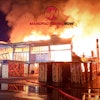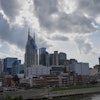On Friday, the National Transportation Safety Board issued an update on the fiery incident on October 28, 2016 that caused the emergency evacuation of 161 passengers on American Airlines flight 383 at O'Hare International Airport.
The accident was caused by an uncontained failure of the GE CF6-80C2B6 engine on a Boeing 767-300 during the takeoff. Not that any accident is safer than another, but an uncontained engine failure is typically more violent and serious because engine debris it thrown at high speeds in multiple directions.
In this case, the right engine stage 2 high pressure turbine disk fractured into at least four pieces. One piece went through the inboard section of the right wing, over the fuselage and into a UPS warehouse facility.
The fracture also triggered the fuel leak, which caused a pool of fire underneath the right wing.
The NTSB recovered most of the disk, and sent it to the NTSB lab in DC. One of the fractures showed signs consistent with fatigue cracking initiating at an internal inclusion near the forward side of the hub’s inner bore.
The team has completed 3D imaging of the damage, and the disk had 10,984 cycles on it, which is less than 75% of its 15,000-cycle life limit. The team is still reviewing engine maintenance and manufacturing records.
Ongoing metallurgical tests on the disk will focus on the inclusion and the fracture surfaces.
Hopefully, between the FAA, Boeing, GE, and American Airlines, we’ll have the root cause that sent the 160 passengers into a panic.
This is IEN Now with David Mantey.






















